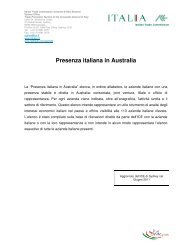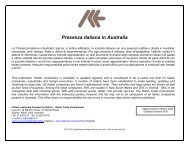Price Determination in the Australian Food Industry A Report
Price Determination in the Australian Food Industry A Report
Price Determination in the Australian Food Industry A Report
Create successful ePaper yourself
Turn your PDF publications into a flip-book with our unique Google optimized e-Paper software.
Figure 103. White sugar, 2kg, supply cha<strong>in</strong> map<br />
Farmer<br />
Primary<br />
Process<br />
Secondary<br />
Process<br />
Market Logistics<br />
Retail<br />
Brand Ownership/ Management<br />
transporter<br />
Farmer<br />
Miller<br />
Ref<strong>in</strong>er<br />
Cha<strong>in</strong> Retailers<br />
Consumer<br />
harvest/haul<br />
Wholesalers<br />
<strong>Food</strong> Service<br />
• Australia produces<br />
between 30–40<br />
million tonnes of<br />
cane per year from<br />
around 450,000 ha.<br />
• Approx. 650 cane<br />
growers but this is<br />
decl<strong>in</strong><strong>in</strong>g.<br />
Queensland is ma<strong>in</strong><br />
production state.<br />
• <strong>Price</strong> drivers<br />
<strong>in</strong>clude Brazilian<br />
crop tonnage, world<br />
oil prices (which<br />
dictate ethanol<br />
production <strong>in</strong><br />
Brazil).<br />
• 5–6m tonnes<br />
of sugar<br />
produced.<br />
• Five mill<br />
owners<br />
account for<br />
100% of<br />
process<strong>in</strong>g.<br />
• Small<br />
companies<br />
are f<strong>in</strong>d<strong>in</strong>g it<br />
<strong>in</strong>creas<strong>in</strong>gly<br />
difficult to<br />
cont<strong>in</strong>ue<br />
process<strong>in</strong>g <strong>in</strong><br />
<strong>the</strong> current<br />
<strong>in</strong>dustry<br />
climate.<br />
Most ref<strong>in</strong><strong>in</strong>g<br />
is collocated<br />
with mill<strong>in</strong>g<br />
and owned by<br />
<strong>the</strong> same<br />
company.<br />
• The supermarket is <strong>the</strong><br />
ma<strong>in</strong> channel for ref<strong>in</strong>ed<br />
sugar sales due to sugar’s<br />
status as a staple.<br />
O<strong>the</strong>r Retailers<br />
• The majority of ref<strong>in</strong>ed<br />
sugar is sold through <strong>the</strong><br />
major supermarket cha<strong>in</strong><br />
stores.<br />
SUGAR – ANALYSIS OF PRICING<br />
Retail versus farmgate prices over time<br />
<strong>Price</strong> <strong>Determ<strong>in</strong>ation</strong> <strong>in</strong> <strong>the</strong> <strong>Australian</strong> <strong>Food</strong> <strong>Industry</strong> A <strong>Report</strong><br />
The comparison of retail and farmgate (equivalent) returns over time is set out <strong>in</strong> Figure 104.<br />
The cane-grow<strong>in</strong>g sector is paid a cane return which is based on a weighted average pooled return<br />
derived from on <strong>the</strong> average returns achieved by millers from export and domestic markets <strong>in</strong> each<br />
season. This is mostly driven by export returns. Payments to <strong>in</strong>dividual producers are based on<br />
agreements with millers based on formulas which <strong>in</strong>clude sugar content and cane quality.<br />
The net average return to <strong>the</strong> cane farmer has steadily been driven down to <strong>the</strong> level of <strong>the</strong> cost of<br />
production.<br />
Retail prices<br />
Though volumes have been static, <strong>the</strong> average value of <strong>the</strong> grocery retail market <strong>in</strong> <strong>the</strong> last 10<br />
years has steadily <strong>in</strong>creased across all packaged sugar product l<strong>in</strong>es.<br />
Retailers often use 2kg white sugar product as a loss leader. This reflects strong competition for<br />
<strong>the</strong> basic 2kg sugar product from a mix of factors, <strong>in</strong>clud<strong>in</strong>g a higher share of <strong>the</strong> market be<strong>in</strong>g<br />
taken by specialty sugar and sweetener products. It also reflects <strong>the</strong> sluggish demand <strong>in</strong> <strong>the</strong> retail<br />
market and <strong>the</strong> frequent use of discount<strong>in</strong>g to stimulate sales. Recently, sugar has been used as<br />
an ‘every day low prices’ product by major retailers.<br />
Value-add<strong>in</strong>g <strong>in</strong> sugar products<br />
There has been limited value-add<strong>in</strong>g to <strong>the</strong> ref<strong>in</strong>ed sugar product, with <strong>the</strong> exception of <strong>the</strong><br />
market<strong>in</strong>g of convenience s<strong>in</strong>gle-serve portions for home and food service use.<br />
96







